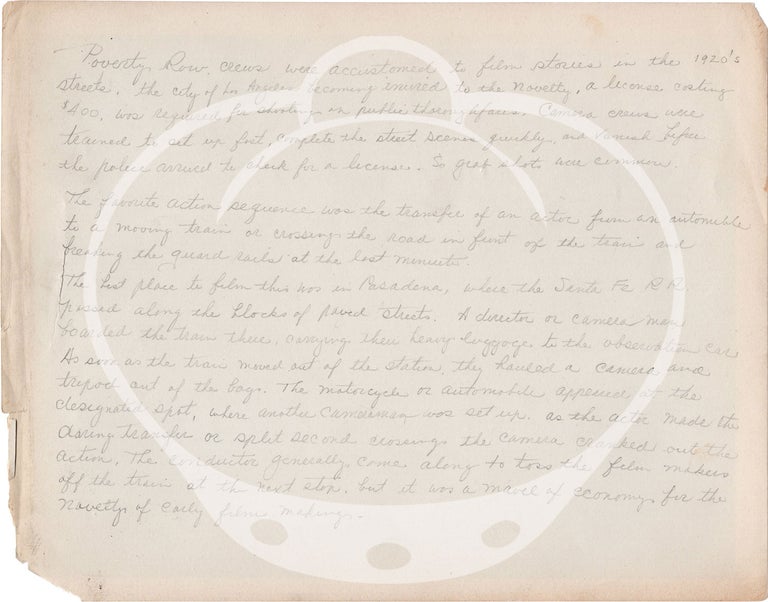Original photograph from the lost film "The Scarlet Streak," circa 1926, of a car jumping a train crossing. With a lengthy annotation on the verso regarding guerilla filming techniques in 1920s Hollywood.
N.p. N.p., Circa 1920s. Vintage reference photograph from the 1926 film. Photograph shot at high film speed, showing a roadster jumping a train crossing, with the train approaching, seconds before (possible) impact. The astute viewer will note that the guard rail has not yet been broken.
With a lengthy annotation in manuscript pencil on the verso, regarding guerilla production techniques taken by Poverty Row studios during the 1920s.
An stunning photograph capturing a split-second moment from a common trope of early action cinema — motorists escaping capture by deftly crossing train tracks, narrowly avoiding collision with an oncoming train. The production number in the bottom left of the photograph, "4296," matches known photographs from the lost 1925 action serial film "The Scarlet Streak," directed by Henry MacRae, and starring Jack Dougherty and Lola Todd.
Just as fascinating is the extensive annotation on the verso:
"Poverty Row crews were accustomed to film stories in the 1920s streets. The city of Los Angeles becoming inured to the novelty, a license costing $400 was required for shooting on public thoroughfares. Camera crews were trained to set up fast, complete the street scenes quickly, and vanish before the police arrived to check for a license. So grab shots were common.
"The favorite action sequence was the transfer of an actor from an automobile to a moving train or crossing the road in front of the train and breaking the guard rails at the last moment.
"The best place to film this was in Pasadena, where the Santa Fe [Railroad] passed along the blocks of paved streets. A director or camera man boarded the train there, carrying their heavy luggage to the observation car. As soon as the train moved out of the station they hauled a camera and tripod out of the bags. The motorcycle or automobile appeared at the designated spot, where another cameraman was set up. As the actor made the daring transfer or split second crossing the camera cranked out the action. The conductor generally came along to toss the film makers off the train at the next stop, but it was a marvel of economy for the novelty of early film making."
10.25 x 8 inches. Very Good plus, with a small chip to the top left margin, chipping to the bottom right margin, with a minutae of image loss to the bottom right corner, and edgewear and creasing to the right margin.
[Book #157265]
Price: $450.00
See all items in: 1920s Cinema, Action Film, Film Still Photographs, Lost Film, On the Set, Photographs, Poverty Row Film, Silent Film
![[Book #157265] Original photograph from the lost film "The Scarlet Streak," circa 1926, of a car jumping a train crossing. With a lengthy annotation on the verso regarding guerilla filming techniques in 1920s Hollywood. Silent cinema.](https://royalbooks.cdn.bibliopolis.com/pictures/157265.jpg?width=768&height=1000&fit=bounds&auto=webp&v=1706260805)
